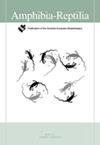乌克兰境内东欧平原水蛙群结构和半克隆繁殖的地理特征
IF 1.3
4区 生物学
Q3 ZOOLOGY
引用次数: 0
摘要
分析了东南欧平原904个水蛙Pelophilax esculentus复合体的种群结构和半克隆繁殖的地理特征。ridibundus的种群比例为0.667,而lessonae的种群比例则为0.042。RE型种群在混合种群中最为常见(0.153)。两个亲本物种和P.kl.esculentus(REL型)的菌落频率分别为0.072和0.046,以及P.lessonae和P.kl.esculent(LE型)的群体频率分别为0.046。所有杂交种群(E型)在整个地区并不多(0.017)。在乌克兰中部、北部和西部的种群中,P.lessonae基因组在杂交后代的配子发生过程中被消除,而在下第聂伯河和下多瑙河流域,P.ridibundus的基因组被消除。在乌克兰东部的种群中,杂交种通常产生二倍体配子或单倍体配子,其染色体组仅为小单胞菌,更罕见的是不同类型配子的混合物。ridibundus在杂交群落中的优势和P.lessonae基因组在杂交中的消除不可避免地导致杂交种群转变为“纯”R型种群。这种情况使得与ridibundus的杂交成为了P.lessonae种群减少的一个因素。这一趋势在森林草原区尤其明显,那里的杂交进行得最为密集,P.lessonae基因组在杂交中被消除,数量优势为P.ridibundus的不稳定种群占主导地位。本文章由计算机程序翻译,如有差异,请以英文原文为准。
Geographic peculiarities of structure and hemicloning reproduction of Pelophylax esculentus water frog complex (Anura, Ranidae) populations in the East European Plain within Ukraine
Geographic peculiarities of population structure and hemicloning reproduction of the water frog Pelophylax esculentus complex of 904 samples within southern East European Plain were analyzed. The proportion of populations of P. ridibundus is 0.667 against those 0.042 of P. lessonae. The RE-type populations are the most common among mixed ones (0.153). The colonies of the two parental species and P. kl. esculentus (REL-type), as well as those of P. lessonae with P. kl. esculentus (LE-type), have the frequencies 0.072 and 0.046, respectively. All-hybrid populations (E-type) are not numerous across the region (0.017). In the populations of Central, Northern and Western Ukraine, the P. lessonae genome is eliminated during gametogenesis within hybrids while in the Lower Dnieper and Lower Danube drainages, genome of P. ridibundus is eliminated. In the Eastern Ukraine populations, hybrids usually produce diploid gametes or haploid gametes with the P. ridibundus genome, less often with the chromosome set of P. lessonae only, and even more rarely a mixture of different types of gametes. The predominance of P. ridibundus in hybrid communities and the elimination of the P. lessonae genome in hybrids inevitably leads to the transformation of hybrid populations into “pure” R-type populations. This circumstance makes hybridization with P. ridibundus a factor in the shrinking of P. lessonae populations. That trend is especially expressed in the Forest steppe zone, where hybridization proceeds most intensively, the P. lessonae genome is eliminated in hybrids, and unstable populations with a numerical superiority of P. ridibundus predominate.
求助全文
通过发布文献求助,成功后即可免费获取论文全文。
去求助
来源期刊

Amphibia-Reptilia
生物-动物学
CiteScore
3.10
自引率
6.20%
发文量
39
审稿时长
6-12 weeks
期刊介绍:
Amphibia-Reptilia is a leading European multi-disciplinary journal devoted to most of the aspects of herpetology: ecology, behaviour, evolution, conservation, physiology, morphology, paleontology, genetics, and systematics.
Amphibia-Reptilia publishes high quality original papers, short-notes, reviews, book reviews and news of the Societas Europaea Herpetologica (SEH). The Societas Europaea Herpteologica (SEH) website is located at: www.seh-herpetology.org.
 求助内容:
求助内容: 应助结果提醒方式:
应助结果提醒方式:


